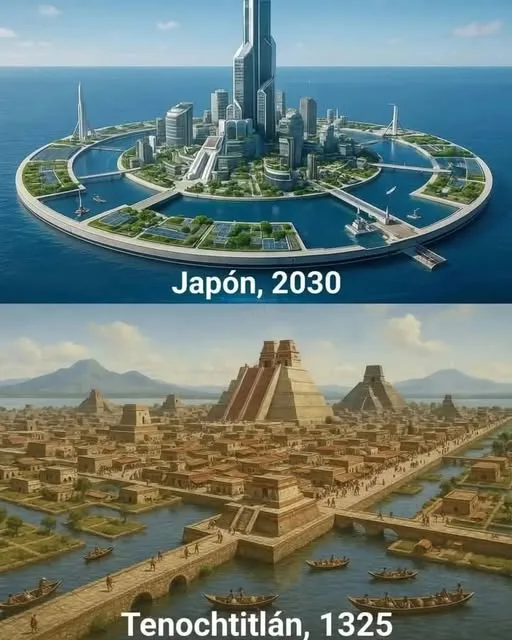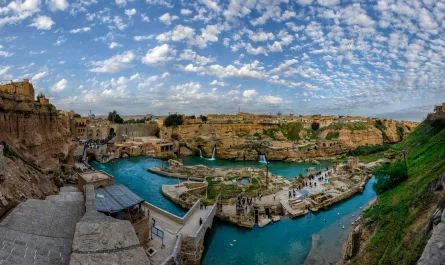Dogen City: Japan’s Visionary Floating Metropolis and Its Echoes of Tenochtitlan

Japan’s ambitious Dogen City, spearheaded by startup N-Ark, promises to redefine urban living by 2030 with a floating, self-sustaining smart city designed to combat climate change and natural disasters. Spanning 4 km in circumference and housing up to 40,000 people (10,000 residents and 30,000 visitors), this innovative project blends cutting-edge technology with sustainable design, drawing inspiration from ancient urban planning marvels like Tenochtitlan, the Aztec capital built on water. Below, we explore Dogen City’s design, sustainability features, and how it parallels the ingenuity of ancient civilizations.
Dogen City: A Blueprint for the Future
Dogen City is envisioned as a climate-resilient, modular urban ecosystem floating on the ocean, capable of withstanding tsunamis, rising sea levels, and other natural disasters prevalent in Japan. Its circular, ring-shaped structure—1.58 km in diameter—creates a sheltered inner bay, protecting residents and infrastructure. The city is organized into three key zones:
Habitable Ring: The outer layer provides public housing, hospitals, schools, parks, stadiums, offices, and hotels. Shaped like a ship’s hull, it acts as a barrier against extreme weather, ensuring safety and livability.
Autonomous Floating Architecture: Within the inner bay, modular floating structures allow flexible reconfiguration of urban functions, adapting to changing needs or population growth.
Underwater Data Center: Located beneath the sea, this innovative facility uses natural ocean cooling to reduce energy consumption, supporting city management, healthcare data analysis, drug discovery simulations, and telemedicine. Its placement also offers protection against cyberattacks.
The city integrates advanced technologies, including:
Rocket Launch Platforms: Supporting space tourism and research, connecting sea and sky.
Smart Healthcare: Residents will access telemedicine, robotic surgery, DNA analysis, and medical research facilities, positioning Dogen City as a global hub for health innovation.
AI and Smart Grids: Real-time environmental monitoring, intelligent transportation, and resource optimization enhance efficiency.
Sustainability at the Core
Sustainability is Dogen City’s cornerstone, addressing environmental challenges through innovative systems:
Renewable Energy: Solar panels, wind turbines, and decentralized battery grids will generate 22,265,000 kW annually, powering the city off-grid.
Food Production: Using regenerative aquaponics and seawater agriculture, the city will produce 7,000 tons of food yearly, including crops like tomatoes and lettuce, leveraging seawater nutrients.
Water Management: Systems will produce 2 million liters of clean water annually through desalination and recycle wastewater, ensuring a sustainable supply.
Waste Reduction: Composting, plastic-free zones, and 3,288 tons of annual garbage disposal aim for near-zero waste.
These features make Dogen City a model for climate adaptation, offering solutions for climate refugees and disaster resilience while fostering a health-centric lifestyle.
Challenges and Skepticism
Despite its promise, Dogen City faces significant hurdles:
Cost: Estimates suggest a construction cost of 100 trillion yen (~$800 billion), requiring substantial investment from Japan’s government and private partners.
Technical Feasibility: Critics question stability during major storms, internet connectivity, and governance models for a floating city.
Environmental Impact: While sustainable, large-scale marine construction could disrupt ocean ecosystems, requiring careful mitigation.
Timeline: The 2030 completion date is ambitious, with no confirmed location or detailed budget disclosed.
Japan’s expertise in maritime engineering and partnerships with academia, industry, and government (via the New Ocean Consortium) bolster confidence, but the project’s scale demands unprecedented coordination.
Echoes of Tenochtitlan: Ancient Wisdom Meets Modern Innovation
Dogen City’s concept of a water-based, self-sustaining city resonates with Tenochtitlan, the Aztec capital founded in 1325 on Lake Texcoco (modern-day Mexico City). Tenochtitlan’s urban planning was a marvel of its time, showcasing principles that align with Dogen City’s vision:
Water-Based Design: Built on an artificial island in a shallow lake, Tenochtitlan used chinampas (floating agricultural plots) to grow food, supporting a population of 200,000–300,000. Like Dogen City’s aquaponics, this system maximized resources in a water-bound environment.
Hydraulic Engineering: The Aztecs constructed causeways, canals, and dikes to manage flooding and connect the city to the mainland, mirroring Dogen City’s tsunami-resistant ring and modular infrastructure.
Urban Organization: Tenochtitlan’s grid-like layout, with a central plaza, temples, and markets, ensured efficient movement and governance, similar to Dogen City’s zoned, walkable design (reachable within an hour).
Sustainability: Chinampas recycled lake nutrients for agriculture, akin to Dogen City’s seawater-based farming. Both cities prioritize self-sufficiency in food and water.
Resilience: Tenochtitlan thrived despite its flood-prone setting, using adaptive engineering. Dogen City aims for similar resilience against rising seas and disasters.
While Tenochtitlan lacked Dogen City’s renewable energy or data centers, its ability to sustain a dense population on water highlights universal principles of adaptability, resource efficiency, and environmental harmony. The Aztecs’ use of canals for transport parallels Dogen City’s planned electric boats and autonomous drones, showing how ancient and modern planners tackle mobility in aquatic settings.
A Modern Reinvention
Dogen City reimagines Tenochtitlan’s water-based urbanism with 21st-century technology. Where the Aztecs used manual labor and local materials, N-Ark leverages AI, renewables, and maritime engineering to create a city that “rises with the oceans instead of sinking beneath them.” Both reflect a deep respect for their environments—Tenochtitlan as a sacred lake city, Dogen City as a “New Ocean” ecosystem. This blend of ancient wisdom and futuristic innovation underscores humanity’s enduring drive to adapt to challenging landscapes.
Why Dogen City Matters
If realized, Dogen City could serve as a global model for coastal cities facing climate threats, offering a blueprint for sustainable, resilient urban living. Its focus on healthcare, education, and disaster preparedness aligns with societal needs in an era of environmental uncertainty. Like Tenochtitlan, which awed Spanish conquerors in 1519, Dogen City aims to inspire awe while solving practical challenges, from feeding its population to powering its infrastructure.
However, its success hinges on overcoming financial, technical, and ecological obstacles. While Tenochtitlan thrived for nearly two centuries, Dogen City must prove its longevity in a world of rapid change. Posts on X reflect excitement about its potential, with users calling it a “floating haven” for climate solutions, though some question its feasibility.
Conclusion
Dogen City is a bold vision for a floating, sustainable future, blending Japan’s technological prowess with lessons from ancient urban planners like those of Tenochtitlan. Its renewable energy, seawater agriculture, underwater data center, and disaster-resilient design position it as a pioneer in addressing climate change and overpopulation. By echoing the Aztecs’ mastery of water-based living, Dogen City reminds us that innovation often builds on timeless principles. As N-Ark moves toward 2030, the world watches to see if this maritime metropolis will float from concept to reality, redefining how we live with the sea.





